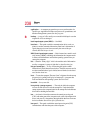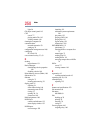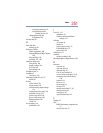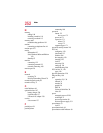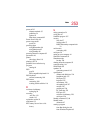
Glossary
Terms
246
PC Card — A credit-card-sized expansion card designed to increase the
capabilities of notebook computers. PC Cards provide functions such
as modem, fax/modem, hard disk drive, network adapter, sound card,
or SCSI adapter.
peripheral — Any device, such as a printer or joystick, that is attached
to the computer and controlled by the computer’s CPU.
pixel — Short for “picture element.” The smallest dot that can be
produced on a screen or printer.
Plug and Play — Generally, refers to the computer’s ability to
automatically configure itself to work with peripheral devices. When
capitalized, refers to a standard that, when followed by a device
manufacturer, allows a PC to configure itself automatically to work
with the device.
pointing device — Any device, such as the AccuPoint or a mouse, that
enables you to move the cursor on the screen.
port — A socket on the computer where you plug in a cable for
connection to a network or a peripheral device.
processor — See central processing unit (CPU).
program — A set of instructions that can be executed by a computer.
The general classes of programs (also called software) are operating
system, application, and utility. See also operating system, application,
utility.
properties — The attributes of an object or device. For example, the
properties of a file include the file’s type, size, and creation date.
R
RAM (random access memory) — Volatile memory that can be
written to as well as read. By volatile, we mean that information in
RAM is lost when you turn off your computer. This type of memory is
used for your computer’s main memory. See also memory. Compare
ROM.
random access memory — See RAM.
read-only memory — See ROM.
reboot — See boot, restart.
removable disk — A disk that can be removed from a disk drive. A
diskette is one example of a removable disk.



